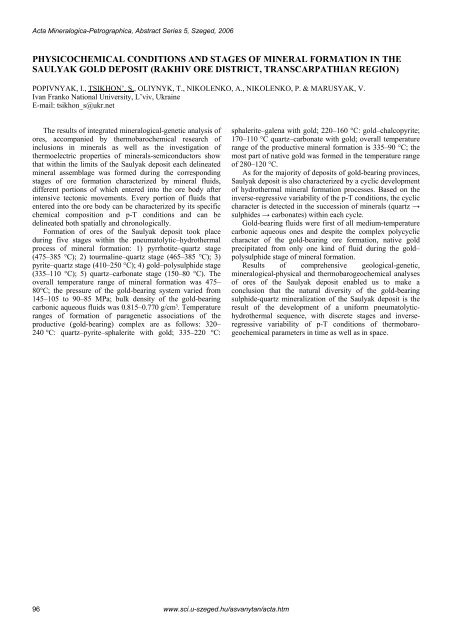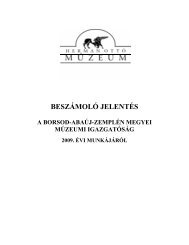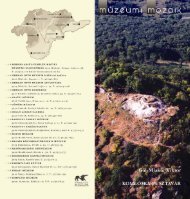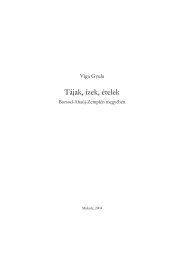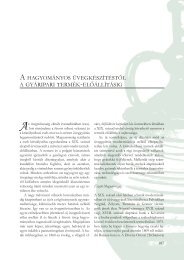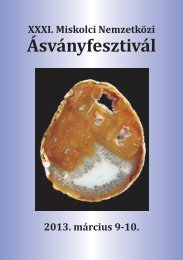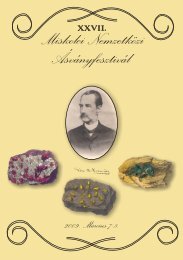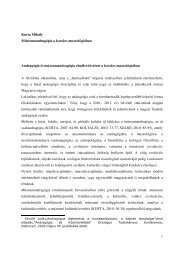Acta Mineralogica-Petrographica, Abstract Series 5, Szeged, 2006PHYSICOCHEMICAL CONDITIONS AND STAGES OF <strong>M<strong>IN</strong>ERAL</strong> FORMATION <strong>IN</strong> <strong>THE</strong>SAULYAK GOLD DEPOSIT (RAKHIV ORE DISTRICT, TRANSCARPATHIAN REGION)POPIVNYAK, I., TSIKHON’, S., OLIYNYK, T., NIKOLENKO, A., NIKOLENKO, P. & MARUSYAK, V.Ivan Franko National University, L’viv, UkraineE-mail: tsikhon_s@ukr.netThe results of integrated mineralogical-genetic analysis ofores, accompanied by thermobarochemical research ofinclusions in minerals as well as the investigation ofthermoelectric properties of minerals-semiconductors showthat within the limits of the Saulyak deposit each delineatedmineral assemblage was formed during the correspondingstages of ore formation characterized by mineral fluids,different portions of which entered into the ore body afterintensive tectonic movements. Every portion of fluids thatentered into the ore body can be characterized by its specificchemical composition and p-T conditions and can bedelineated both spatially and chronologically.Formation of ores of the Saulyak deposit took placeduring five stages within the pneumatolytic–hydrothermalprocess of mineral formation: 1) pyrrhotite–quartz stage(475–385 °С); 2) tourmaline–quartz stage (465–385 °С); 3)pyrite–quartz stage (410–250 °С); 4) gold–polysulphide stage(335–110 °С); 5) quartz–carbonate stage (150–80 °С). Theoverall temperature range of mineral formation was 475–80°С; the pressure of the gold-bearing system varied from145–105 to 90–85 MPa; bulk density of the gold-bearingcarbonic aqueous fluids was 0.815–0.770 g/сm 3 . Temperatureranges of formation of paragenetic associations of theproductive (gold-bearing) complex are as follows: 320–240 °С: quartz–pyrite–sphalerite with gold; 335–220 °С:sphalerite–galena with gold; 220–160 °С: gold–chalcopyrite;170–110 °С quartz–carbonate with gold; overall temperaturerange of the productive mineral formation is 335–90 °С; themost part of native gold was formed in the temperature rangeof 280–120 °С.As for the majority of deposits of gold-bearing provinces,Saulyak deposit is also characterized by a cyclic developmentof hydrothermal mineral formation processes. Based on theinverse-regressive variability of the p-T conditions, the cycliccharacter is detected in the succession of minerals (quartz →sulphides → carbonates) within each cycle.Gold-bearing fluids were first of all medium-temperaturecarbonic aqueous ones and despite the complex polycycliccharacter of the gold-bearing ore formation, native goldprecipitated from only one kind of fluid during the gold–polysulphide stage of mineral formation.Results of comprehensive geological-genetic,mineralogical-physical and thermobarogeochemical analysesof ores of the Saulyak deposit enabled us to make aconclusion that the natural diversity of the gold-bearingsulphide-quartz mineralization of the Saulyak deposit is theresult of the development of a uniform pneumatolytichydrothermalsequence, with discrete stages and inverseregressivevariability of p-T conditions of thermobarogeochemicalparameters in time as well as in space.96www.sci.u-szeged.hu/asvanytan/acta.htm
Acta Mineralogica-Petrographica, Abstract Series 5, Szeged, 2006RELATIONSHIPS BETWEEN <strong>THE</strong> PROPERTIES OF FERRIMAGNETIC NANOCRYSTALSAND BIOLOGICAL CONTROL OVER CRYSTAL GROWTH <strong>IN</strong> MAGNETOTACTICBACTERIAPÓSFAI, M. 1 , KÓSA, I. 1 , KASAMA, T. 2 , CHONG, R. K. K. 3 , SIMPSON, E. T. 3 , F<strong>IN</strong>LAYSON, A. P. 3 ,DUN<strong>IN</strong>-BORKOWSKI, R. E. 3 , BUSECK, P. R. 4 & FRANKEL, R. B. 51 Department of Earth and Environmental Sciences, University of Veszprém, Veszprém, POB 158, HungaryE-mail: posfaim@almos.vein.hu2 Frontier Research System, The Institute of Physical and Chemical Research, Japan3 Department of Materials Science and Metallurgy, University of Cambridge, Pembroke Street, Cambridge, UK4 Department of Geological Sciences, Arizona State University, Tempe, AZ, USA5 Department of Physics, California State University, San Luis Obispo, CA, USAWe have used several advanced transmission electron microscopytechniques to study the physical and chemical propertiesof intracellular ferrimagnetic magnetite (Fe 3 O 4 ) andgreigite (Fe 3 S 4 ) crystals in magnetotactic bacteria that hadbeen collected from lakes and streams. Our measurementsprovide indirect information about mechanisms of biomineralization.The orientations and morphologies of magnetite crystalsin a double magnetosome chain were identified using electrondiffraction, high-resolution electron microscopy andhigh-angle annular dark field electron tomography. Each ofthe two chains is analogous to beads on a string, in whichbiological control appears to be stricter in setting the [111]magnetocrystalline easy axis of the crystals to be parallel tothe chain axis than in constraining their orientation about thisdirection. We used off-axis electron holography to recordmagnetic induction maps from the same particles. The magneticsignal was dominated by inter-particle interactions andby the shapes of the individual crystals.We studied the diversity of magnetosomes in bacteria collectedfrom Lake Balaton. In stained thin sections of cocci,magnetite crystals appear to be anchored to the inner cellmembrane. They are enveloped by stained material, whichmay correspond to the magnetosome membrane. The sectionscontain no detectable iron outside the magnetite magnetosomes.The shapes, orientations, microstructures and magneticproperties of iron sulfide nanocrystals in magnetotactic bacteriathat had been collected from salt marshes were also studied.Rod-shaped cells were found to contain multiple chainsof greigite magnetosomes with random shapes and orientations.Many of the greigite crystals appeared to be onlyweakly magnetic, presumably because their magnetic inductiondirection was almost parallel to the electron beam. Thedisordered three-dimensional arrangement of the crystals in amultiple chain resulted in the magnetic field in the chainfollowing a meandering path between adjacent crystals. Nevertheless,the magnetosomes were observed to collectivelycomprise a permanent magnetic dipole moment that is sufficientfor magnetotaxis. Over a three-year period, with thesample stored in air, each greigite crystal developed an amorphousiron oxide shell and its magnetic moment decreased.When taken together, these results provide a better understandingof magnetotaxis in sulfide-producing cells, and theyhave implications for the interpretation of paleomagneticsignals recorded from greigite-bearing sedimentary rocks.www.sci.u-szeged.hu/asvanytan/acta.htm 97
- Page 1:
MSCC33 rd MINERAL SCIENCES IN THE C
- Page 5 and 6:
Acta Mineralogica-Petrographica, Ab
- Page 7 and 8:
Acta Mineralogica-Petrographica, Ab
- Page 9 and 10:
Acta Mineralogica-Petrographica, Ab
- Page 11 and 12:
Acta Mineralogica-Petrographica, Ab
- Page 13 and 14:
Acta Mineralogica-Petrographica, Ab
- Page 15 and 16:
Acta Mineralogica-Petrographica, Ab
- Page 17 and 18:
Acta Mineralogica-Petrographica, Ab
- Page 19 and 20:
Acta Mineralogica-Petrographica, Ab
- Page 21 and 22:
Acta Mineralogica-Petrographica, Ab
- Page 23 and 24:
Acta Mineralogica-Petrographica, Ab
- Page 25 and 26:
Acta Mineralogica-Petrographica, Ab
- Page 27 and 28:
Acta Mineralogica-Petrographica, Ab
- Page 29 and 30:
Acta Mineralogica-Petrographica, Ab
- Page 31 and 32:
Acta Mineralogica-Petrographica, Ab
- Page 33 and 34:
Acta Mineralogica-Petrographica, Ab
- Page 35 and 36:
Acta Mineralogica-Petrographica, Ab
- Page 37 and 38:
Acta Mineralogica-Petrographica, Ab
- Page 39 and 40:
Acta Mineralogica-Petrographica, Ab
- Page 41 and 42:
Acta Mineralogica-Petrographica, Ab
- Page 43 and 44:
Acta Mineralogica-Petrographica, Ab
- Page 45 and 46: Acta Mineralogica-Petrographica, Ab
- Page 47 and 48: Acta Mineralogica-Petrographica, Ab
- Page 49 and 50: Acta Mineralogica-Petrographica, Ab
- Page 51 and 52: Acta Mineralogica-Petrographica, Ab
- Page 53 and 54: Acta Mineralogica-Petrographica, Ab
- Page 55 and 56: Acta Mineralogica-Petrographica, Ab
- Page 57 and 58: Acta Mineralogica-Petrographica, Ab
- Page 59 and 60: Acta Mineralogica-Petrographica, Ab
- Page 61 and 62: Acta Mineralogica-Petrographica, Ab
- Page 63 and 64: Acta Mineralogica-Petrographica, Ab
- Page 65 and 66: Acta Mineralogica-Petrographica, Ab
- Page 67 and 68: Acta Mineralogica-Petrographica, Ab
- Page 69 and 70: Acta Mineralogica-Petrographica, Ab
- Page 71 and 72: Acta Mineralogica-Petrographica, Ab
- Page 73 and 74: Acta Mineralogica-Petrographica, Ab
- Page 75 and 76: Acta Mineralogica-Petrographica, Ab
- Page 77 and 78: Acta Mineralogica-Petrographica, Ab
- Page 79 and 80: Acta Mineralogica-Petrographica, Ab
- Page 81 and 82: Acta Mineralogica-Petrographica, Ab
- Page 83 and 84: Acta Mineralogica-Petrographica, Ab
- Page 85 and 86: Acta Mineralogica-Petrographica, Ab
- Page 87 and 88: Acta Mineralogica-Petrographica, Ab
- Page 89 and 90: Acta Mineralogica-Petrographica, Ab
- Page 91 and 92: Acta Mineralogica-Petrographica, Ab
- Page 93 and 94: Acta Mineralogica-Petrographica, Ab
- Page 95: Acta Mineralogica-Petrographica, Ab
- Page 99 and 100: Acta Mineralogica-Petrographica, Ab
- Page 101 and 102: Acta Mineralogica-Petrographica, Ab
- Page 103 and 104: Acta Mineralogica-Petrographica, Ab
- Page 105 and 106: Acta Mineralogica-Petrographica, Ab
- Page 107 and 108: Acta Mineralogica-Petrographica, Ab
- Page 109 and 110: Acta Mineralogica-Petrographica, Ab
- Page 111 and 112: Acta Mineralogica-Petrographica, Ab
- Page 113 and 114: Acta Mineralogica-Petrographica, Ab
- Page 115 and 116: Acta Mineralogica-Petrographica, Ab
- Page 117 and 118: Acta Mineralogica-Petrographica, Ab
- Page 119 and 120: Acta Mineralogica-Petrographica, Ab
- Page 121 and 122: Acta Mineralogica-Petrographica, Ab
- Page 123 and 124: Acta Mineralogica-Petrographica, Ab
- Page 125 and 126: Acta Mineralogica-Petrographica, Ab
- Page 127 and 128: Acta Mineralogica-Petrographica, Ab
- Page 129 and 130: Acta Mineralogica-Petrographica, Ab
- Page 131 and 132: Acta Mineralogica-Petrographica, Ab
- Page 133 and 134: Acta Mineralogica-Petrographica, Ab


